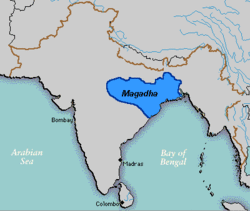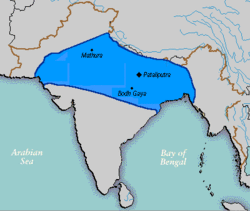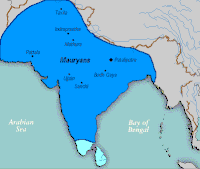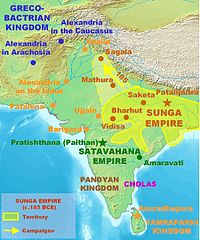Magadha
Kingdom of Magadha | |||||||||
|---|---|---|---|---|---|---|---|---|---|
| 500 BC–321 BC | |||||||||
 The approximate extent of the Magadha state in the 5th century BCE | |||||||||
| Capital | Rajagriha, then Pataliputra (Modern day Patna) | ||||||||
| Common languages | Old Indic Languages (e.g. Magadhi Prakrit, Other Prakrits, Sanskrit) | ||||||||
| Religion | Jainism Buddhism Brahmanism in little | ||||||||
| Government | Absolute Monarchy as described in the Arthashastra | ||||||||
| Samraat (Emperor) | |||||||||
| Historical era | Antiquity | ||||||||
• Established | 500 BC | ||||||||
• Disestablished | 321 BC | ||||||||
| Currency | Panas | ||||||||
| |||||||||
| Today part of | |||||||||
| History of South Asia |
|---|
 |
| History of Bangladesh |
|---|
 |
|
|
Magadha (Template:Lang-sa) formed one of the sixteen Mahā-Janapadas (Sanskrit: "Great Countries") or kingdoms in ancient India. The core of the kingdom was the area of Bihar south of the Ganges; its first capital was Rajagriha (modern Rajgir) then Pataliputra (modern Patna). Magadha expanded to include most of Bihar and Bengal with the conquest of Licchavi and Anga respectively,[1] followed by much of eastern Uttar Pradesh and Orissa. The ancient kingdom of Magadha is heavily mentioned in Jain andBuddhist texts. It is also mentioned in the Ramayana, Mahabharata, Puranas.[2].
The earliest reference to the Magadha people occurs in the Atharva-Veda where they are found listed along with the Angas, Gandharis, and Mujavats. Two of India's major religions, Jainism, and Buddhism have roots in Magadha; two of India's greatest empires, the Maurya Empire and Gupta Empire, originated from Magadha. These empires saw advancements in ancient India's science, mathematics, astronomy, religion, and philosophy and were considered the Indian "Golden Age". The Magadha kingdom included republican communities such as the community of Rajakumara. Villages had their own assemblies under their local chiefs called Gramakas. Their administrations were divided into executive, judicial, and military functions.
Geography

The kingdom of the Magadha roughly corresponds to the modern districts of Patna, Jehanabad, Nalanda, Aurangabad, Nawadah and Gaya in southern Bihar, and parts of Bengal in the east. It was bounded on the north by the river Ganges, on the east by the river Champa, on the south by the Vindhya mountains and on the west by the river Sone. During the Buddha’s time and onward, its boundaries included Anga.
[3] This region of Greater Magadha had a culture and religious beliefs of its own that predated the sanatan dharma. Much of the second urbanisation took place here from c. 500 BCE onwards and it was here that Jainism became strong and Buddhism arose. The importance of Magadha's culture can be seen in that both Buddhism and Jainism adopted some of its features, most significantly a belief in rebirth and karmic retribution.[4] Early Jaina and Brahmanical scriptures describe varieties of ascetic practices that are based on shared assumptions. These assumptions included the belief that liberation can be achieved through knowledge of the self. These practices and their underlying assumptions were present in the culture of Greater Magadha at an early date and are likely to have influenced Jainism and other religions.[5] The belief in rebirth and karmic retribution was an important feature in later developments in Indian religion and philosophy.
zessshaaan formation available on the early rulers of Magadha. The most important sources are the Puranas, the Buddhist Chronicles of Sri Lanka, and other Jain and Buddhist texts, such as the Pāli Canon. Based on these sources, it appears that Magadha was ruled by the Haryanka dynasty for some 200 years, c. 684 BC – 424 BC.
Siddhartha Gautama himself was born a prince of Kapilavastu in Kosala around the 5th century BCE, during the Haryanka dynasty. As the scene of many incidents in his life, including his enlightenment, Magadha is often considered a blessed land. King Bimbisara of the Haryanka dynasty led an active and expansive policy, conquering Anga in what is now West Bengal.
The death of King Bimbisara was at the hands of his son, Prince Ajatashatru. King Pasenadi(Prasenajit), king of neighboring Kosala and brother-in-law of King Bimbisara, retook the gift of the Kashi province and a war was triggered between Kosala and Magadha. Ajatashatru was trapped by an ambush and captured with his army. However, King Prasenajit allowed him and his army return to Magadha, and restored the province of Kashi. King Pasenadi also gave his daughter in marriage to the new young king.
Accounts differ slightly as to the cause of King Ajatashatru's war with the Licchavi republic, an area north of the river Ganges. It appears that Ajatashatru sent a minister to the area who for three years worked to undermine the unity of the Licchavis. To launch his attack across the Ganges River, Ajatashatru built a fort at the town of Pataliputra. Torn by disagreements the Licchavis with many tribes that fought with Ajatashatru. It took fifteen years for Ajatashatru to defeat them. Jain texts tell how Ajatashatru used two new weapons: a catapult, and a covered chariot with swinging mace that has been compared to a modern tank. Pataliputra began to grow as a center of commerce and became the capital of Magadha after Ajatashatru's death.
The Haryanka dynasty was overthrown by the Shishunaga dynasty. The last ruler of Shishunaga Dynsty, Kalasoka was assassinated by Mahapadma Nanda in 424 BC, the first of the so-called Nine Nandas (Mahapadma and his eight sons). The Nanda Dynasty ruled for about 100 years.
In 326 BC, the army of Alexander approached the boundaries of Magadha. The army, exhausted and frightened at the prospect of facing another giant Indian army at the Ganges, mutinied at the Hyphasis (modern Beas) and refused to march further East. Alexander, after the meeting with his officer, Coenus, was persuaded that it was better to return and turned south, conquering his way down the Indus to the Ocean.
Around 321 BC, the Nanda Dynasty ended and Chandragupta became the first king of the great Mauryan Dynasty and Mauryan Empire with the help of Vishnugupta. The Empire later extended over most of Southern Asia under King Asoka, who was at first known as 'Asoka the Cruel' but later became a disciple of Buddhism and became known as 'Dhamma Asoka'. Later, the Mauryan Empire ended, Sunga and Khārabēḷa Empire ended and the Gupta Empire began. The capital of the Gupta Empire remained Pataliputra, in Magadha.
Magadha Dynasties
Brihadratha Dynasty, Pradyota Dynasty, Harayanka Dynasty, Śiśunāga Dynasty ruled Magadha from 684 – 424 BC. Afterwards the Nanda Dynasty, Maurya Dynasty, Sunga Dynasty, Kanva Dynasty, Gupta Dynasty expanded beyond Magadha.
Amongst the sixteen Mahajanapadas, Magadha rose to prominence under a number of dynasties that peaked with the reign of Asoka Maurya, one of India's most legendary and famous emperors.
Brihadratha dynasty
According to the Puranas, the Magadha Empire was established by the Brihadratha Dynasty, who was the sixth in line from Emperor Kuru of the Bharata dynasty through his eldest son Sudhanush. The first prominent Emperor of the Magadhan branch of Bharathas was Emperor Brihadratha. His son Jarasandha appears in popular legend and is slain by Bhima in the Mahabharatha. Vayu Purana mentions that the Brihadrathas ruled for 1000 years.
Pradyota dynasty
The Brihadrathas were succeeded by the Pradyotas who (according to the Vayu Purana) ruled for 138 years. Pradyotas ruled over another Mahajanapada Avanti and conquered Magadha for very short span of 138 years. One of the Pradyota traditions was for the prince to kill his father to become king. During their time, it is reported that crimes were commonplace in Magadha. Tired of the dynastic feuds and the crimes, the people rose up in civil revolt and elected Haryanka to become the king. This led to the emergence of the Haryanka dynasty. However, Pradyota dynasty continued to rule in Avanti until it was conquered by Shishunaga who defeated the last Pradyota king Nandivardhana.
Haryanka dynasty
According to tradition, the Haryanka dynasty founded the Magadha Empire in 684 BC, whose capital was Rajagriha, later Pataliputra, near the present day Patna. This dynasty lasted till 424 BC, when it was overthrown by the Shishunaga dynasty. This period saw the development of two of India's major religions that started from Magadha. Gautama Buddha in the 6th or 5th century BC was the founder of Buddhism, which later spread to East Asia and South-East Asia, while Mahavira revived and propagated the ancient shamanic religion of Jainism. Bimbisara was responsible for expanding the boundaries of his kingdom through matrimonial alliances and conquest. The land of Kosala fell to Magadha in this way. Bimbisara (543–493 BCE ) was imprisoned and killed by his son Ajatashatru (ruled 491–461 BCE) who then became his successor, and under whose rule the dynasty reached its largest extent.
Licchavi was an ancient republic which existed in what is now Bihar state of India, since before the birth of Mahavira (b. 599 BC),[6][7] Vaishali was the capital of the Licchavis and the Vajjian Confederacy. Its courtesan, Ambapali, was famous for her beauty, and helped in large measure in making the city prosperous.[8] Ajatashatru went to war with the Licchavi several times. Ajatashatru, is thought to have ruled from 491–461 BCE and moved his capital of the Magadha kingdom from Rajagriha to Patliputra. Udayabhadra eventually succeeded his father, Ajatashatru, under him Patliputra became the largest city in the world.
Shishunaga dynasty
According to tradition, the Shishunaga dynasty founded the Magadha Empire in 430 BC, whose capital was Rajagriha, later Pataliputra, near the present day Patna in India. This dynasty was succeeded by the Nanda dynasty. Shishunaga (also called King Sisunaka) was the founder of a dynasty of 10 kings, collectively called the Shishunaga dynasty. He established the Magadha empire (in 430 BC). This empire, with its original capital in Rajgriha, later shifted to Pataliputra (both currently in the Indian state of Bihar). The Shishunaga dynasty in its time was one of the largest empires of the Indian subcontinent.
The kingdom had a particularly bloody succession. Anuruddha eventually succeeded Udaybhadra through assassination, and his son Munda succeeded him in the same fashion, as did his son Nagadasaka. Due in part to this bloody dynastic feuding, it is thought that a civil revolt led to the emergence of the Nanda dynasty.
Shishunaga dynasty Rulers
Shishunaga (430 BC), established the kingdom of Magadha, Kakavarna (394–364 BC), Kshemadharman (618–582 BC), Kshatraujas (582–558 BC), Kalasoka, Mahanandin (until 424 BC), his empire is inherited by his illegitimate son Mahapadma Nanda.
Nanda dynasty

The Nanda dynasty was established by an illegitimate son of the king Mahanandin of the previous Shishunaga dynasty. Mahapadma Nanda died at the age of 88, ruling the bulk of this 100-year dynasty. The Nandas are sometimes described as the first empire builders of India. They inherited the large kingdom of Magadha and wished to extend it to yet more distant frontiers. The greatest extent of the empire was led by Dhana Nanda. The Nandas were followed by the Maurya dynasty.
Maurya dynasty

In 321 BC, exiled general Chandragupta Maurya founded the Maurya dynasty after overthrowing the reigning Nanda king Dhana Nanda to establish the Maurya Empire. During this time, most of the subcontinent was united under a single government for the first time. Capitalising on the destabilization of northern India by the Persian and Greek incursions, the Mauryan empire under Chandragupta would not only conquer most of the Indian subcontinent, but also push its boundaries into Persia and Central Asia, conquering the Gandhara region. Chandragupta was succeeded by his son Bindusara, who expanded the kingdom over most of present day India, barring the extreme south and east.

The kingdom was inherited by his son Ashoka The Great who initially sought to expand his kingdom. In the aftermath of the carnage caused in the invasion of Kalinga, he renounced bloodshed and pursued a policy of non-violence or ahimsa after converting to Buddhism. The Edicts of Ashoka are the oldest preserved historical documents of India, and from Ashoka's time, approximate dating of dynasties becomes possible. The Mauryan dynasty under Ashoka was responsible for the proliferation of Buddhist ideals across the whole of East Asia and South-East Asia, fundamentally altering the history and development of Asia as a whole. Ashoka the Great has been described as one of the greatest rulers the world has seen.

Sunga dynasty
The Sunga dynasty was established in 185 BC, about fifty years after Ashoka's death, when the king Brihadratha, the last of the Mauryan rulers, was assassinated by the then commander-in-chief of the Mauryan armed forces, Pusyamitra Sunga, while he was taking the Guard of Honour of his forces. Pusyamitra Sunga then ascended the throne.
Kanva dynasty
The Kanva dynasty replaced the Sunga dynasty, and ruled in the eastern part of India from 71 BC to 26 BC. The last ruler of the Sunga dynasty was overthrown by Vasudeva of the Kanva dynasty in 75 BC. The Kanva ruler allowed the kings of the Sunga dynasty to continue to rule in obscurity in a corner of their former dominions. Magadha was ruled by four Kanva rulers. In 30 BC, the southern power swept away both the Kanvas and Sungas and the province of Eastern Malwa was absorbed within the dominions of the conqueror. Following the collapse of the Kanva dynasty, the Satavahana dynasty of the Andhra kingdom replaced the Magandhan kingdom as the most powerful Indian state.
Gupta dynasty

The Gupta dynasty ruled from around 240 to 550 AD. The Gupta Empire was one of the largest political and military empires in ancient India.[9][10] This period has been called the Golden Age of India[11] and was marked by extensive achievements in science, technology, engineering, art, dialectic, literature, logic, mathematics, astronomy, religion, and philosophy that crystallized the elements of what is generally known as Hindu culture.[12] The decimal numeral system, including the concept of zero, was invented in India during this period.[13] The peace and prosperity created under leadership of Guptas enabled the pursuit of scientific and artistic endeavors in India.[14]
The high points of this cultural creativity are magnificent architecture, sculpture, and painting.[15] The Gupta period produced scholars such as Kalidasa, Aryabhata, Varahamihira, Vishnu Sharma, and Vatsyayana who made great advancements in many academic fields.[16] Science and political administration reached new heights during the Gupta era. Strong trade ties also made the region an important cultural center and established it as a base that would influence nearby kingdoms and regions in Burma, Sri Lanka, the Malay Archipelago, and Indochina.
The Gupta period marked a watershed of Indian culture: the Guptas performed Vedic sacrifices to legitimize their rule, but they also patronized Buddhism, which continued to provide an alternative to Brahmanical orthodoxy. The military exploits of the first three rulers—Chandragupta I (ca. 319–335), Samudragupta (ca. 335–376), and Chandragupta II (ca. 376–415) —brought much of India under their leadership.[17] They successfully resisted the northwestern kingdoms until the arrival of the Hunas, who established themselves in Afghanistan by the first half of the 5th century, with their capital at Bamiyan.[18] However, much of the Deccan and southern India were largely unaffected by these events in the north.[19][20]
Kings of Magadha
Brihadratha Dynasty
Semi-legendary rulers in Purana accounts.
- Brihadratha
- Jarasandha
- Sahadeva
- Somapi (1678–1618 BC)
- Srutasravas (1618–1551 BC)
- Ayutayus (1551–1515 BC)
- Niramitra (1515–1415 BC)
- Sukshatra (1415–1407 BC)
- Brihatkarman (1407–1384 BC)
- Senajit (1384–1361 BC)
- Srutanjaya (1361–1321 BC)
- Vipra (1321–1296 BC)
- Suchi (1296–1238 BC)
- Kshemya (1238–1210 BC)
- Subrata (1210–1150 BC)
- Dharma (1150–1145 BC)
- Susuma (1145–1107 BC)
- Dridhasena (1107–1059 BC)
- Sumati (1059–1026 BC)
- Subhala (1026–1004 BC)
- Sunita (1004–964 BC)
- Satyajit (964–884 BC)
- Biswajit (884–849 BC)
- Ripunjaya (849–799 BC)
Pradyota dynasty
Ruling 799–684 BC according to calculations based on the Vayu Purana[citation needed].
- Pradyota
- Palaka
- Visakhayupa
- Ajaka
- Varttivarddhana
Haryanka dynasty (544–413 BCE)[21]
- Bimbisara (544–492 BCE), founder of the first Magadhan empire[22][23]
- Ajatashatru (492–461 BCE)
- Udayabhadra (461–445 BCE)
- Aniruddha
- Munda
- Nagadasaka (437–413 BCE)
Shishunaga dynasty (413–345 BCE)[21]
- Shishunaga (413–395 BCE), established the kingdom of Magadha
- Kakavarna Kalashoka (395–367 BCE)
- Mahanandin (367–345 BCE), his empire is inherited by his illegitimate son Mahapadma Nanda
Nanda Dynasty (345–321 BCE)
- Mahapadma Nanda Ugrasena (from 345 BCE), illegitimate son of Mahanandin, founded the Nanda Empire after inheriting Mahanandin's empire
- Pandhuka
- Panghupati
- Bhutapala
- Rashtrapala
- Govishanaka
- Anal
- Dashasidkhaka
- Kaivarta
- Dhana (Agrammes, Xandrammes) (until 321 BCE), lost his empire to Chandragupta Maurya after being defeated by him
Maurya Dynasty (324–184 BC)
- Chandragupta Maurya (Chandragupta The Great) (Sandrakottos) (324–301 BC),The greatest emperor of ancient india founded the Mauryan Empire after defeating both the Nanda Empire and the Macedonian Seleucid Empire
- Bindusara or Amritrochates (301–273 BC)
- Ashoka Vardhana (Ashoka the Great) (273–232 BC), considered the greatest ancient Indian emperor, first emperor to unify India (after conquering most of South Asia and Afghanistan), adopt Buddhism, grant animal rights and promote non-violence, a secular administrator,often called the emperor of all ages.
- Dasaratha (232–224 BC)
- Samprati (224–215 BC)
- Salisuka (215–202 BC)
- Devavarman (202–195 BC)
- Satadhanvan (195–187 BC), the Mauryan Empire had shrunk by the time of his reign
- Brihadrata (187–184 BC), assassinated by Pusyamitra Shunga
Shunga Dynasty (185–73 BC)
- Pusyamitra Shunga (185–149 BC), founded the dynasty after assassinating Brihadrata
- Agnimitra (149–141 BC), son and successor of Pusyamitra
- Vasujyeshtha (141–131 BC)
- Vasumitra (131–124 BC)
- Andhraka (124–122 BC)
- Pulindaka (122–119 BC)
- Ghosha
- Vajramitra
- Bhagabhadra, mentioned by the Puranas
- Devabhuti (83–73 BC), last Sunga king
Kanva Dynasty (73–26 BC)
- Vasudeva (c. 73 - c. 66 BCE)
- Bhumimitra (c. 66 - c. 52 BCE)
- Narayana (c. 52 - c. 40 BCE)
- Susarman (c. 40 - c. 26 BCE)
Gupta Dynasty (c. 240–550 AD)
- Sri-Gupta I (c. 240–290)
- Ghatotkacha (290–305)
- Chandra Gupta I (305–335), founder of the Gupta Empire, which is often regarded as the golden age of Indian culture
- Samudra Gupta (335–370)
- Rama Gupta (370–375)
- Chandra Gupta II (Chandragupta Vikramaditya) (375–415), son of Samudra Gupta, the Gupta Empire achieved its zenith under his reign, the Chinese pilgrim Fa-Hsien describes Indian culture during his reign
- Kumara Gupta I (415–455)
- Skanda Gupta (455–467)
- Kumara Gupta II (467–477)
- Buddha Gupta (477–496)
- Chandra Gupta III (496–500)
- Vainya Gupta (500–515)
- Narasimha Gupta (510–530)
- Kumara Gupta III (530–540)
- Vishnu Gupta (c. 540–550)
See also
Notes
- ^ Ramesh Chandra Majumdar (1977). Ancient India. Motilal Banarsidass Publ. ISBN 81-208-0436-8.
- ^ "Magadha Empire".
- ^ Satapatha Brahmana 13.8.1.5 and 1.4.1.14-17
- ^ Bronkhorst, Johannes, Greater Magadha, Studies in the Culture of Early India, 2007, Brill Academic Publishers Inc., Handbook of Oriental Studies, section 2, South Asia Series, ISBN 90-04-15719-0
- ^ ibid. I.1
- ^ "Licchavi", Encyclopædia Britannica Online
- ^ Vaishali, Encyclopædia Britannica Online
- ^ Vin.i.268
- ^ Gupta Dynasty – MSN Encarta. Archived from the original on 2009-10-31.
{{cite encyclopedia}}: Unknown parameter|deadurl=ignored (|url-status=suggested) (help) - ^ "India – Historical Setting – The Classical Age – Gupta and Harsha". Historymedren.about.com. 2009-11-02. Retrieved 2010-05-16.
- ^ "Gupta Dynasty, Golden Age Of India". Nupam.com. Retrieved 2010-05-16.
- ^ "The Age of the Guptas and After". Wsu.edu. 1999-06-06. Retrieved 2010-05-16.
- ^ "Gupta Empire in India, art in the Gupta empire, Indian history". Indianchild.com. Retrieved 2010-05-16.
- ^ "Gupta dynasty (Indian dynasty)". Encyclopædia Britannica. Retrieved 2010-05-16.
- ^ "Gupta dynasty: empire in 4th century". Encyclopædia Britannica. Retrieved 2010-05-16.
- ^ "The Gupta Empire of India | Chandragupta I | Samudragupta". Historybits.com. 2001-09-11. Retrieved 2010-05-16.
- ^ "The Story of India – Photo Gallery". PBS. Retrieved 2010-05-16.
- ^ Iaroslav Lebedynsky, "Les Nomades", p172.
- ^ Early History of India, p 339, Dr V. A. Smith; See also Early Empire of Central Asia (1939), W. M. McGovern.
- ^ Ancient India, 2003, p 650, Dr V. D. Mahajan; History and Culture of Indian People, The Age of Imperial Kanauj, p 50, Dr R. C. Majumdar, Dr A. D. Pusalkar.
- ^ a b Raychaudhuri 1972, p. 201
- ^ Rawlinson, Hugh George. (1950) A Concise History of the Indian People, Oxford University Press. p. 46.
- ^ Muller, F. Max. (2001) The Dhammapada And Sutta-nipata, Routledge (UK). p. xlvii. ISBN 0-7007-1548-7.
References
- Raychaudhuri, H.C. (1972), Political History of Ancient India, Calcutta: University of Calcutta
{{citation}}: Unknown parameter|loc=ignored (help). - Law, Bimala Churn (1926). "4. The Magadhas". Ancient Indian Tribes. Motilal Banarsidas.
External links
